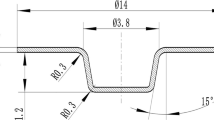Abstract
Laser shock forming (LSF) technology employs shock waves to form sheet metal into three-dimensional complex parts, and has application potential in manufacturing sheet metal parts. In this paper, the forming of 2024 aluminum alloy sheet with LSF was investigated through numerical and experimental methods. The numerical model was established with the commercial code ABAQUS/Explicit. The formed conical cup was obtained from the simulation, and validated by the experiment. With the verified numerical model, the deformation behaviors, including deformation velocity, sheet thickness variation and strain distribution, were studied. In addition, the influence of different shock wave pressures on the forming precision was also investigated. The experimental and numerical results show that the metal sheet loaded by shock wave can take the shape of the mold, and the non-uniform thickness is distributed in the formed cup. The investigations also display that there exists reverse deformation at the central region of deforming sheet owing to severe collision during LSF. In order to obtain formed part with better quality, an appropriate pressure of applied shock waves is required.









Similar content being viewed by others
References
Mamutov AV, Golovashchenko SF, Mamutov VS (2015) Modeling of electrohydraulic forming of sheet metal parts. J Mater Process Technol 219:84–100
Mousavi SAAA, Riahi M, Parast AH (2007) Experimental and numerical analyses of explosive free forming. J Mater Process Technol 187–188:512–516
Zhang X, Wang ZR, Song FM, Yu LZ, Lu X (2004) Finite element simulation of the electromagnetic piercing of sheet metal. J Mater Process Technol 151:350–354
Karimi A, Niayesh K, Bahmani MA (2010) Magnetic filed enhancement in electromagnetic forming systems using anisotropic materials. Int J Mater Form 3(3):205–208
Zhou M, Zhang YK, Cai L (2002) Laser shock forming on coated metal sheets characterized by ultrahigh-strain-rate plastic deformation. J Appl Phys 91(8):5501–5503
Carr AR, Walker A, Combaz E (2015) Derivation of a forming limit stress diagram from an experimental FLC, and comparison of the two criteria when applied to FE simulation of a pressing using different yield functions. Int J Mater Form 8(1):45–57
Sigvant M, Mattiasson K, Vegter H, ThilderKvist P (2009) A viscous pressure bulge test for the determination of a plastic hardening curve and equibiaxial material data. Int J Mater Form 2(4):235–242
Niehoff HS, Vollertsen F (2005) Non-thermal laser stretch-forming. Adv Mater Res 6–8:433–440
Cheng GJ, Pirzada D, Ming Z (2007) Microstructure and mechanical property characterizations of metal foil after microscale laser dynamic forming. J Appl Phys 101(6):063108
Zhang XQ, She JP, Li SZ, Duan SW, Zhou Y, Yu XL, Zheng R, Zhang B (2015) Simulation on deforming progress and stress evolution during laser shock forming with finite element method. J Mater Process Technol 220:27–35
Gao H, Ye C, Cheng GJ (2009) Deformation behaviors and critical parameters in microscale laser dynamic forming. J Manuf Sci Eng 131(5):051011
Li J, Cheng GJ (2010) Multiple-pulse laser dynamic forming of metallic thin films for microscale three dimensional shapes. J Appl Phys 108(1):013107
Jiang YF, Huang Y, Jin H, Gu YY, Ren AG, Huang LW, Qian XM (2013) Research on precision control of sheet metal forming by laser shock waves with semi-die. Opt Laser Technol 45(1):598–604
Shen ZB, Liu HX, Wang X, Wang CT (2016) Improving the forming capability of laser dynamic forming by using rubber as a forming medium. Appl Surf Sci 369:288–298
Fabbro R, Fournier J, Ballard P, Devaux D, Virmont J (1990) Physical study of laser-produced plasma in confined geometry. J Appl Phys 68(2):775–784
Zhang WW, Yao YL (2002) Micro scale laser shock processing of metallic components. J Manuf Sci Eng 124(2):369–378
Johnson GR, Cook WH (1983) A constitutive model and data for metals subjected to large strains, high strain rates and high temperatures. Proceedings of the 7th ISB: pp. 541–547
Ocaña JL, Correa C, García-Beltrán A, Porro JA, Díaz M, Ruiz-de-Lara L, Peral D (2015) Laser shock processing of thin Al2024-T351 plates for induction of through-thickness compressive residual stresses fields. J Mater Process Technol 223:8–15
Gill AS, Telang A, Vasudevan VK (2015) Characteristics of surface layers formed on inconel 718 by laser shock peening with and without a protective coating. J Mater Process Technol 225:463–472
Jorgensen DJ, Pollock TM, Begley MR (2015) Dynamic response of thin films on substrates subjected to femtosecond laser pulses. Acta Mater 84:136–144
Guglielmotti A, Quadrini F, Squeo EA, Tagliaferri V (2009) Diode laser bending of tongues from slotted steel tubes. Int J Mater Form 2(2):107–111
Mohammadi A, Vanhove H, Bael AV, Duflou JR (2016) Towards accuracy improvement in single point incremental forming of shallow parts formed under laser assisted conditions. Int J Mater Form 9(3):339–351
Peyre P, Berthe L, Scherpereel X, Fabbro R (1998) Laser-shock processing of aluminium-coated 55C1 steel in water-confinement regime, characterization and application to high-cycle fatigue behaviour. J Mater Sci 33(6):1421–1429
Zheng C, Sun S, Ji Z, Wang W, Liu J (2010) Numerical simulation and experimentation of micro scale laser bulge forming. Int J Mach Tools Manuf 50(12):1048–1056
Wang X, Ma YJ, Shen ZB, Gu YX, Zhang D, Qiu TB, Liu HX (2015) Size effects on formability in microscale laser dynamic forming of copper foil. J Mater Process Technol 220:173–183
Author information
Authors and Affiliations
Corresponding author
Ethics declarations
Funding
This study was founded by the National Natural Science Foundation of China (grant number: 51175002, 51675002) and State Key Laboratory of Materials Processing and Die & Mould Technology, Huazhong University of Science and Technology (grant number: P2017-007).
Conflict of interest
All authors declare that we have no conflict of interest.
Rights and permissions
About this article
Cite this article
Zhang, X., Zhang, Y., Zhang, Y. et al. Numerical and experimental investigations of laser shock forming aluminum alloy sheet with mold. Int J Mater Form 11, 101–112 (2018). https://doi.org/10.1007/s12289-016-1333-4
Received:
Accepted:
Published:
Issue Date:
DOI: https://doi.org/10.1007/s12289-016-1333-4



